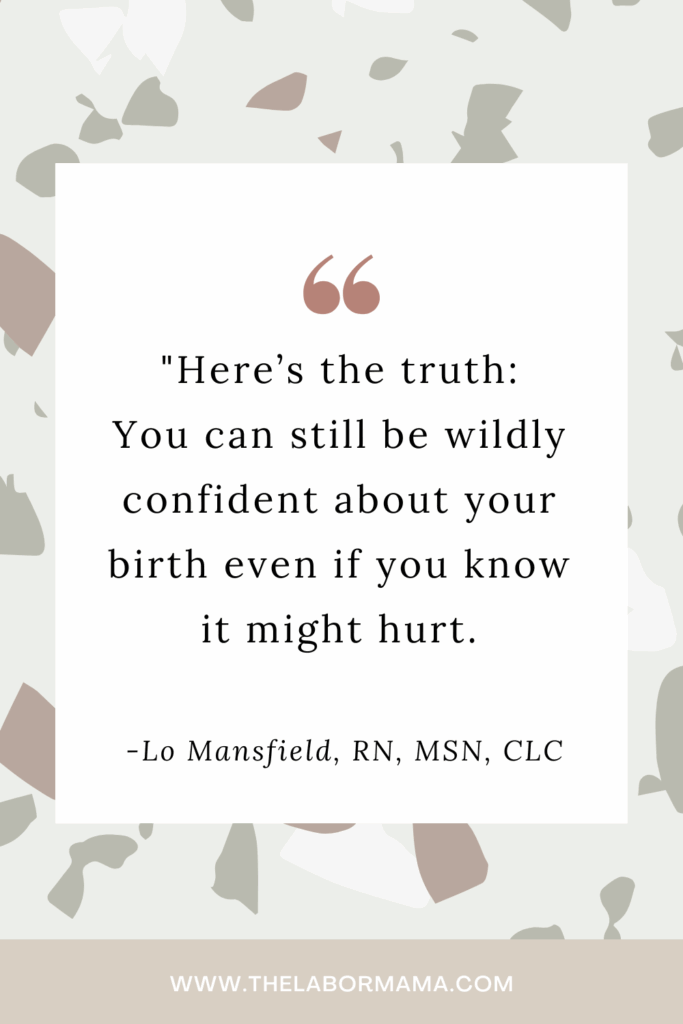If you’ve ever seen a post or reel about pain-free birth and thought, “That’s amazing—but also, what?!?”—you’re not alone. This conversation can stir up hope, curiosity, even confusion. Maybe your best friend swears her birth didn’t hurt. Maybe you’re deep in birth prep and wondering if you can achieve the same. Or maybe you’re sitting there thinking, That’s cute… but not my vibe.
Wherever you are on the birth plan spectrum—from “Give me the epidural at 4 cm” to “I want an unmedicated, unassisted birth in my living room”—this blog is for you. Let’s dig into what pain-free birth really means, what labor pain actually is, and how to make peace with your own unique birth experience.
More of a listener? Check out this episode of The Lo & Behold podcast ➡️ Is Pain Free Birth Real, Should You Want it, and Can You Do It?
Before We Get Into It – Who is The Labor Mama and Why Am I Here?
Hey friend! I’m Lo – also known around here and social media as The Labor Mama. I’ve spent my nursing career in labor, delivery, and postpartum, have birthed 4 of my own babies, have labored thousands of mamas at the bedside, have taught hundreds of students online, and have even delivered a few speedy little babies with my bare hands (oops).
Here at TLM, I offer online classes to empower you the way everyone should be. The education + support I offer gives you experience, evidence, and empathy; you’re getting all of my years of “clinical” RN knowledge, beautifully combined with my real experiences as a mama and a nurse. These are not your average hospital classes (those won’t do it, I promise), and honestly, birth, postpartum, and breastfeeding don’t follow a textbook or protocol anyway. You need to know so much more than that!
If you want to connect with me further, head to Instagram. There are hundreds of thousands of us over there learning together daily.
A note: This post may include affiliate links. This means if you make a purchase after clicking a link, I will earn a small commission (thank you)! Rest assured, this comes at no additional cost to you. You can read TLM’s full disclosure here.
First, Can We Talk About Labor Pain?
As a nurse, birth educator, and mom who’s been in the thick of it, I can tell you: labor pain is complicated—and deeply individual.
We tend to talk about labor pain as one big thing, but in reality, there are two core components:
Biological (the body):
- Uterine contractions
- Pressure
- Stretching of the cervix or vaginal canal
- Baby’s head on your spine (yes, ouch)
Psychological (the mind):
- Fear of the unknown
- Anxiety
- Past experiences
- Mental narratives about pain
These two layers interact constantly, and that’s where the Fear → Tension → Pain Cycle comes in.
Understanding the Fear–Tension–Pain Cycle
Ever clenched up before a shot and made it feel worse? That’s the fear–tension–pain cycle in action.
In labor, fear can cause tension (clenched fists, tight jaw, rigid shoulders). That tension? It amplifies the pain. And then the pain reinforces the fear… and around we go.
The solution? We interrupt the cycle—starting with the mind. And that is where the pain-free birth conversation gets really interesting. If you want to dig further into the fear-tension-pain cycle, check out this blog post.
So… Is Pain-Free Birth Actually Real?
Short answer: Yes. For some people.
But let’s break that down.
Pain-free birth isn’t just about having a high pain tolerance or getting lucky. For many who experience it, it’s the result of intentional, practiced control over the mind and nervous system.
There are two systems at play in all of this: 1) Your sympathetic nervous system/SNS (that’s the fight or flight one) and 2) Your parasympathetic nervous system/PNS (that’s the calm and peace one). Both are good, important, and necessary for life. But in labor? We’ve got to figure out how to control them in really intentional ways.
How? That practice mind and nervous system control. This is called Central Nervous System Control (CNSC)—and it’s powerful.
Your thoughts → influence your nervous system → which changes how you experience pain.
In labor and birth, that SNS flares up and wants to GO. But you can use, influence, and activate your parasympathetic nervous system, which does a good job at quieting the SNS or diminishing what it is trying to do. The SNS is not always bad – often it can save our lives. But in labor, you’ve got to figure out how to get it to chill a bit!
This type of control doesn’t mean you can stop contractions. The physical of labor is always present. But practicing control over your mind and your thoughts, and using that control to utilize the PNS does mean you might experience the physical parts of pain differently. For some, that means less pain. And for some, that can mean no pain at all.
What Helps People Experience Less (or No) Pain in Labor?
If pain-free birth is your goal—or if you just want to feel more in control during labor (that should be all of us, right?)—here are tools that really make a difference.
- Childbirth education (the #1 game-changer for reducing fear + increasing confidence)
- Hypnobirthing or Hypnobabies
- Aromatherapy + calming music
- Touch + massage
- Relaxation techniques + breathing work
These tools all shift your body into a more relaxed, less reactive state—which then activates your PNS, interrupts the pain cycle and the SNS, and ultimately, creates more calm.
Not Ready for a Full Course? Start with the Unmedicated Birth Guide
If you’re intrigued by the idea of unmedicated birth—but you’re not quite ready to dive into a full birth course—I created something just for you.
💡 The Unmedicated Birth Guide is a 100+ page comprehensive digital guide that helps you confidently prepare for birth without medication. It’s perfect for the mama who’s saying:
- “I’m curious about going without the epidural, but need support.”
- “I’ve seen all the scary stories—where are the good ones?”
- “I want to trust my body, but I don’t know how to start.”
Inside the guide, you’ll learn how to:
- Build a solid birth team that shows up for you
- Understand the labor process mentally, physically, and emotionally
- Work with your body during contractions
- Fill your toolkit with strategies, rituals, and real support
- Create a birth plan and environment that feels safe, calm, and yours
✨ Whether you’re 8 weeks out or just starting to explore what birth could look like—this guide will help you go from overwhelmed to empowered.
➡️ Grab the Unmedicated Birth Guide for just $37 and take the first step toward a birth that actually feels like yours.
Wait—But What If I’m a Wimp with Pain?
Let’s get this straight: pain tolerance in everyday life has zero correlation to how you’ll handle labor.
Hate paper cuts? Cry when you stub your toe? That doesn’t mean you won’t crush your birth.
Here’s why labor pain is different:
- It has purpose- You’re not just hurting—your body is working toward meeting your baby.
- It comes with emotional meaning- That this-is-hard-but-I’m-so-close feeling? It shifts how you respond.
- Your body responds differently- Hormones like endorphins, oxytocin, and adrenaline are built-in pain relievers that show up in labor to help you cope. (I LOVE this sciency stuff, so I definitely get into this in the birth course).
You don’t need to be “good at pain.” You just need to understand what your body is doing, recognize it’s purposeful and good, and then get the tools to support it.
What If You Don’t Want a Pain-Free Birth?
Maybe you’re sitting there thinking, This all sounds great, but I don’t think a pain-free birth is for me. Maybe you want the epidural at 4 cm. Or maybe you’re like me and you’re pursuing an unmedicated birth, not necessarily a pain-free one. That’s 100% valid.
Here’s the truth:
You can still be wildly confident about your birth even if you know it might hurt.
You can believe it’s going to be hard, and still show up prepared.
You can expect pain, and still walk in full of peace.
You don’t have to chase a pain-free goal to be powerful.
But you do need to do something to prepare. Labor isn’t the time to wing it. So here are a few questions to help you think through how you want to approach labor pain:
1. What Are Your Expectations About Pain?
Where did they come from? Was it a story your mom told you? A viral birth video? A past experience?
And—maybe most importantly—do those expectations need refining?
Sometimes we carry fear that isn’t even ours. Let yourself get curious and reshape your story.
2. How Are You Learning—and From Who?
Evidence is clear: quality birth education changes birth outcomes. So ask yourself:
- Is what you’re learning comprehensive?
- Is it honest, not fear-based?
- Does it leave space for your unique experience?
You deserve education that informs you, not education that pressures you.
3. Do You Know the Emotional Signposts of Labor?
These are real, physiological markers tied to the stages of labor—not woo-woo stuff. When you understand them, you’ll be less likely to fear them. You’ll think:
“Oh, this emotional shift? That means I’m in transition. This is a good sign. I’m almost there.”
That awareness can be grounding in the middle of intensity.
I’ve got a quick podcast episode on this topic – BOTH OF YOU should listen to it. Check it out here.
4. Are You Using Your Breath?
Your lungs are one of your most underrated tools.
The way you breathe in labor can literally influence how much pain you feel. Your breath can activate the parasympathetic nervous system (your body’s “rest and calm” mode) and reduce your fear—and therefore, your pain.
Deep, intentional breathing isn’t just a strategy for unmedicated birth—it helps with:
- C-section recovery
- Postpartum cramping
- That first postpartum bathroom trip 🙃
So start practicing now. You don’t need fancy techniques. Just start noticing your breath and trying different patterns. J-breathing, box breathing, cleansing breaths—try them and see what feels good to you.
Here’s What I Want You to Walk Away With
You don’t need to fear pain.
You don’t need to chase a pain-free birth unless you want to.
You don’t need to compare your story to anyone else’s.
What you do need? Tools. Knowledge. Confidence.
And the reminder that no matter how labor unfolds—you did not fail.
Whether you:
- Have a pain-free birth
- Think it’s the hardest thing you’ve ever done
- Feel strong, even if it hurts
- Surprise yourself with how well you coped
- Every one of those is valid.
Every one of those is real.
Every one of those is birth.
Final Thoughts on Pain-Free, Unmedicated Birth
Labor pain can be understood. It can be prepared for. It can even be minimized—or for some, completely eliminated. But it is not a test. It is not a measure of your strength, your worth, or your success.
We all come into birth with different bodies, different minds, and different stories. Your job isn’t to birth like anyone else—it’s to birth like you.
That’s what we focus on inside Your Body, Your Birth: helping you learn the tools, understand the science, and walk into your birth with clarity and calm. Not perfection—just power.
Let’s build your toolbox.
Let’s support your unique story.
Let’s birth on your terms.
xx-Lo
More resources (and freebies!) for you to take a peek at:
- Comprehensive Birth Plan and Birth Priorities templates
- A complete Third Trimester Checklist
- The RN + mama of 4 Ultimate Packing List
- The Labor Mama online birth, baby and breastfeeding classes for every family
Liked this post? Don’t forget to Pin it!






